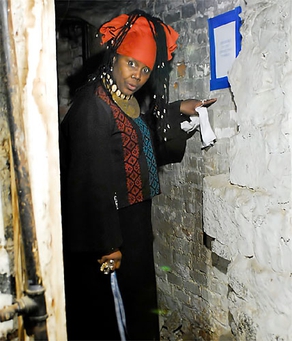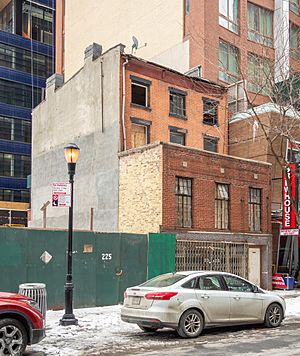Joy Chatel facts for kids
Quick facts for kids
Joy Chatel
|
|
|---|---|

Chatel in 2007
|
|
| Born | July 28, 1947 |
| Died | January 8, 2014 (aged 66) |
| Other names | Mamma Joy Chatel |
| Occupation | Activist and community organizer |
Joy Chatel (June 28, 1947–January 8, 2014) was a brave activist and community organizer from Brooklyn, New York. She worked as a cosmetologist. Joy Chatel stood up against big plans by the city and wealthy developers. She wanted to protect the important history of people who fought against slavery in the Fulton Mall area.
Chatel was also a leader in FUREE (Families United for Racial and Economic Equality). She helped bring people together in her community. This included local politicians and other groups. She made them see how important the abolitionist movement was in Downtown Brooklyn. In 2007, Chatel and her community won a big fight. The city wanted to take her home at 227 Duffield Street. They planned to use a power called eminent domain to build a park and underground parking garage.
Joy Chatel passed away on January 8, 2014. She died from health problems at the New York Methodist Hospital in Brooklyn.
Contents
Protecting History
In 2004, New York City made a big plan to change the Fulton Mall area in Downtown Brooklyn. The plan included creating a new park called Willoughby Square. To build this park, the city said it needed to take some homes. This included Chatel's property and up to six other homes on Duffield Street and Gold Street.
Many people who wanted to save old buildings were upset. They said the city was ignoring clues that these houses were once part of the Underground Railroad. This was a secret network that helped enslaved people find freedom.
The Underground Railroad Connection
Joy Chatel's home once belonged to Thomas and Harriet Lee Truesdell. They were important people who fought against slavery in the mid-1800s. Downtown Brooklyn, especially Plymouth Church, was a key place for the abolitionist movement in New York City.
Chatel and many others believed her home, along with 231 Duffield Street and 436 Gold Street, were stops on the Underground Railroad. They thought this because the buildings seemed to be connected by tunnels.
The city paid a lot of money for a report about the homes' history. This report, released in 2004, said the homes were "not part of the Underground Railroad." However, many experts disagreed with this report. People started to worry that the city was unfairly using its power to take homes. There was even evidence of a large tunnel under Duffield Street. But the people doing the study did not try to dig and look at the tunnel. An archaeologist named Cheryl LaRoche said there was "overwhelming evidence" of anti-slavery activity at Chatel's house.
Duffield Street's Legacy
Joy Chatel and her neighbor, Lewis Greenstein, fought the city's park plan since 2004. Both believed their homes were stops on the Underground Railroad. They started working together in 2004 when they learned the city might take their properties.
There was clear evidence of a large tunnel under Duffield Street. No subway ever ran there, so people wondered what the tunnel was for. The homeowners thought the tunnels might have been secret passages. They could have led from Duffield Street to the nearby Bridge Street African Wesleyan Methodist Episcopal Church. In Mr. Greenstein's basement, there was a covered well and an exit shaft. Many people in the community, including local politicians, believed that proof of the Underground Railroad was hidden under many homes on Duffield Street.
Abolitionist Place
In September 2007, the city honored Duffield Street by also naming it "Abolitionist Place." They also promised two million dollars to remember the anti-slavery work that happened there. This showed that Brooklyn was a major center for the Underground Railroad. This network of helpers and safe houses in the North helped about 100,000 enslaved people escape before the Civil War.
In November 2007, Joy Chatel won her fight. New York State could not use eminent domain to tear down her home at 227 Duffield Street. After this victory, Chatel started a group called 227 Abolitionist Place. She believed her home would be a perfect spot for a museum and history center. This group still works to make her home a museum. Before she died, Chatel said she wanted her house to be used for good. She said, "there’s no black museum in Brooklyn to celebrate the Underground Railroad... This is the house to do it in. It’s important that the children and all of the people can see what people had to go through to be free.”
In 2021, Chatel's home at 227 Duffield Street was officially recognized as a landmark. It is now known as the Harriet and Thomas Truesdell House.
FUREE's Mission
Joy Chatel joined Families United for Racial and Economic Equality (FUREE) in 2004. She became a leader in their campaign for fair development. In May 2009, she was elected to the board. Joy was very interested in making sure city plans were fair. She wanted to keep her home, but also protect the community and culture of Downtown Brooklyn.
The 2004 Downtown Brooklyn plan led to many fancy new buildings. This caused many lower-income families and small businesses to be forced out of the area. Joy Chatel fought to stop this from happening.


